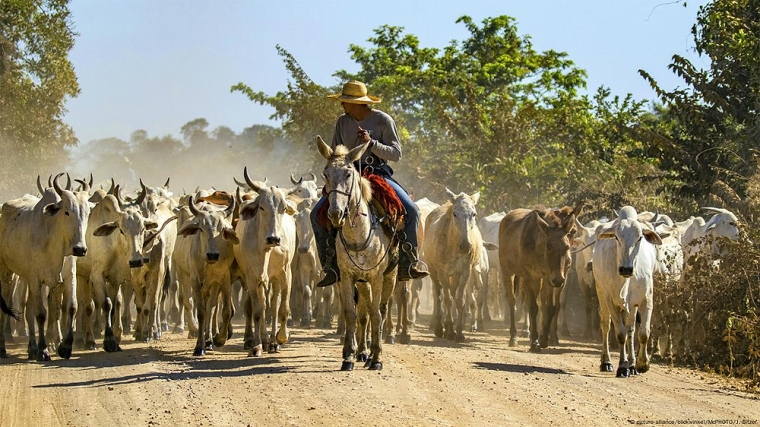
Brazil’s beef juggernaut is not slowing down. While New Zealand remains focused on producing premium, sustainable beef for high-value markets, Brazil is charging ahead with sheer volume -driven largely by its formidable zebu cattle.
These so-called “super cows” have transformed the global beef supply chain, making Brazil the world’s largest exporter of beef and offering a compelling case study in how breeding, policy and politics can reshape a nation’s agricultural fortunes.
At the centre of Brazil’s beef dominance is the zebu, a breed of cattle genetically refined over generations to thrive in tropical conditions and produce high-quality meat. ExpoZebu, the country’s premier cattle fair, is a celebration of these animals and a showcase of Brazil’s relentless pursuit of genetic excellence. “The zebu animals are huge,” said photographer Carolina Aranches, who has spent over a decade documenting their rise. “They are tall - some of them bigger than 1.7 or 1.8 metres. Big horns, white skin and noted for the hump they have over the neck. Very powerful animals.”
That hump isn’t just a signature feature, it’s also the source of a prized Brazilian beef cut known as cupim, popular at family barbecues. The animal’s appearance, movement and structure are all scrutinised at ExpoZebu, where the elite among Brazil’s 225 million cattle are paraded like livestock royalty. “They wash the animals every day, shave them, feed them nutritional food and provide 24-hour care,” said Carolina. “Winning a prize at ExpoZebu can mean big financial rewards.”
The rewards can be staggering. One cow, Vietina 19, sold for the equivalent of NZ$6.5 million, obviously not to be eaten, but to serve as a genetic cornerstone for the next generation. The most desirable bulls are similarly valuable. One, named Gabriel, sired over 600,000 offspring. In Brazil, the cattle are no longer just beef they are biological investments.
It’s a remarkable transformation, particularly when you consider that zebu cattle weren’t even native to Brazil. According to historian Oscar Broughton, Brazil’s early cattle industry was dominated by small Criollo cattle from the Iberian Peninsula, which were used primarily to feed enslaved populations and support sugar production. These animals were ill-suited to tropical conditions and as Brazil’s population urbanised and global beef demand surged in the late 19th century, policymakers began to look elsewhere.
India provided the answer. Zebu cattle with their longer legs, slow metabolism and resistance to tropical diseases were imported in increasing numbers between 1893 and 1914. As the 20th century progressed, Brazil developed its own national breeds and by the time World War I began, beef had already started to rival traditional Brazilian exports like coffee and sugar.
The zebu’s rise mirrored Brazil’s changing political landscape. During the military dictatorship that began in 1964, beef became a cornerstone of the national economy. The government established the Brazilian Agricultural Research Corporation (Embrapa) to lead scientific advances in livestock breeding, pasture management and feed production. Cattle ranchers became a political force, forming part of the “BBB” bloc-beef, bullets and Bibles - a conservative coalition that still holds considerable sway in Brazilian politics.
Today, Brazil’s zebu herd outnumbers its human population and the country continues to expand production, driven largely by demand from China which now takes almost half of all Brazilian beef exports. “We export 30 to 35 percent of what we produce,” said Cassio Browner, Associate Professor of Animal Science at the Federal University of Pelotas. “In the past 10 years, exports to China have increased fourteenfold.”
Brazil’s competitive edge comes from its low-cost production model. “Our beef industry is based on pastures, which is very cheap,” said Cassio. “Labour is also very competitive compared to other countries, like the United States.” This makes Brazilian beef not just abundant, but affordable for international markets and for Brazilian consumers, many of whom enjoy beef daily, especially during weekend barbecues.
But all this expansion comes at a cost. The environmental toll of cattle farming in Brazil, particularly in the Amazon is significant. Economist Marcus Barroso from DePaul University explained that the impact is primarily carbon released during land clearing. “Cattle production in the Amazon is particularly environmentally impactful,” he said. “You need to cut down the forest, burn it and that process releases carbon into the atmosphere.”
Much of this land is used only temporarily before degradation forces ranchers to move on, repeating the cycle. And while zebu cattle do produce less methane and consume less feed per kilo of beef than other breeds, due to their rapid growth rates, the sheer scale of expansion is difficult to ignore. “Cattle ranching has a different environmental impact depending on where you are,” Marcus added. “In some areas it’s less severe, but in the Amazon the cost is particularly high.”
The political will to shift cattle production away from ecologically sensitive areas is lacking. “Even though cattle ranching in the Amazon is remarkably unproductive, it’s still one of the few sources of revenue for state governments in the region,” said Marcus. Moving cattle south to more temperate zones, may make sense environmentally, but it’s unlikely to gain traction politically.
Despite these concerns, the zebu’s genetic advantages offer global potential. With climate conditions becoming more extreme, the resilience of zebu cattle could provide solutions for other beef-producing nations. “Those animals will spread out the genetics that we need to help other countries improve their production,” said Cassio.
So, can Brazil’s super cows feed the world? They’re certainly trying and succeeding. But as they do, questions around environmental sustainability and global equity become increasingly urgent. Brazil’s model is effective but it comes at a cost, one that the planet may not be able to afford indefinitely.
Which brings us back to New Zealand. We’ll never compete with Brazil on volume, nor should we try. Our future lies in staying firmly focused on quality, sustainability and targeting the wealthiest, most discerning markets.
We produce enough to feed around 40 million people and it makes far more sense to feed the 40 million who care deeply about where their food comes from than to chase the commodity market. Let Brazil meet the bulk demand. Our strength lies in producing superior, sustainable protein for environmentally conscious consumers. That’s where our competitive advantage is, and that’s where our future lies.
Have a listen to the podcast to hear the full story.
Angus Kebbell is the Producer at Tailwind Media. You can contact him here.
4 Comments
Because we never had to cut down bush to grow pasture?
My thoughts exactly redcows, farming cattle on erodible hill country won't last. Also we are entirely dependent on imported fertilizer.
Having said that NZ does have areas where cattle can be raised and fattened sustainably in the long term. But yes the forest was cleared from the land first.
Yep we wrote the how to manual. Bit ironic we now frown upon others who are doing what we did exceptionally well.
What are the great things we are doing or have to do to access these markets? It seems to me many in the industry are fighting as hard as possible to not do many of them? Be careful assuming all Brazil are pirates. From what I've read and seen they are well ahead of us on many sustainable things.
Sometimes wonder why Fonterra hasn’t entered into beef processing. That is to service the cow and bull manufacturing beef which is more or less now a by product of dairying. Such a plant set up for warm boning is a straight through process, slaughter, bone, pack, freeze. No chillers needed before or after nor any vac pac machines as for premium steer cuts etc. Invites too, developing mechanical boning techniques.

We welcome your comments below. If you are not already registered, please register to comment.
Remember we welcome robust, respectful and insightful debate. We don't welcome abusive or defamatory comments and will de-register those repeatedly making such comments. Our current comment policy is here.